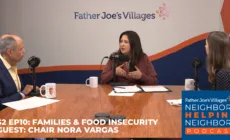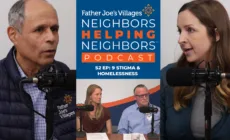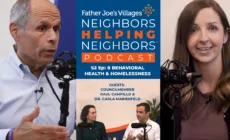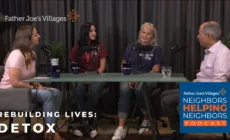Independent Report by Point Loma Nazarene University’s Fermanian Business & Economic Institute Validates Pilot Project Managed by Father Joe’s Villages.
Results: 36 formerly homeless people housed + 67 percent reduction in public resource costs = $3.5 million of taxpayer and other social service dollars saved over the course of a 24 month period.1
These are the final outcomes for Project 25, United Way’s initiative to permanently house at least 25 of San Diego County’s chronically homeless2, high frequency users of public resources.
“The results are impressive,” said Dr. Lynn Reaser, Chief Economist for the Fermanian Business and Economic Institute at Point Loma Nazarene University. The Institute produced an independent report on the outcomes of Project 25, which uses the “Housing First” model to house participants in permanent homes and provide supportive services to keep them housed.
“We started this pilot project in 2011 to determine whether permanent supportive housing works in San Diego – and now we know the answer is a resounding ‘yes,’” said Kevin Crawford, president and CEO, United Way of San Diego County. “Using a ‘Collective Impact’ approach to bring all the necessary agencies and resources together, we have found that it costs more to do nothing – both in quality of life and taxpayer dollars.”
Reaser concluded, “Providing chronically homeless and frequent users of public resources with stable and secure housing, combined with a comprehensive set of health and social services, can yield a dramatic reduction in the use and expense of various public services”
Conceived of and funded by United Way with $1.5 million over three years, Project 25 is a historic public-private partnership between the County of San Diego, City of San Diego/ San Diego Housing Commission and United Way. The San Diego Housing Commission awarded 25 federal housing vouchers from the U.S. Department of Housing and Urban Development to Project 25. Father Joe’s Villages, San Diego’s largest homeless service provider, managed the pilot and will continue to oversee the program moving forward.
“I am tremendously proud of the trail Father Joe’s blazed with our work on Project 25, critical to assess how San Diego can best help the most needy among our chronically homeless population,” said Deacon Jim F. Vargas, president and CEO, Father Joe’s Villages. “With the help of public and private funding and the continued federal housing support from the Housing Commission, we are expanding the program and continuing our work to tailor solutions to the individuals who come to us at a critical turning point in their lives.” United Way provided $100,000 of additional bridge funding in the program’s fourth year to help boost fundraising.
The report, “Project 25: Helping the Most Frequent Users of Public Services,” analyzed 28 individuals enrolled in the program and housed in the first year. The individuals ranged in age from 22 to 61, with a median age of 47. Five were veterans. All of the individuals studied had some form of mental illness, a serious physical disability and/or a diagnosable substance abuse disorder. Many had all three.
As a result of Project 25, the median expense per user decreased from nearly $111,000 in 2010 to less than $12,000 in 2013.
Final results, as validated by the Fermanian Institute, include3:
| Service Type | One year before Project 25 (Homeless) | While in Project 25 in 2012 | While in Project 25 in 2013 | % Change from base year to 2013 |
| Ambulance Rides | $279,576 | $122,647 | $90,182 | -67.7% |
| Arrests | $12,300 | $3,750 | $2,700 | -78% |
| ER Visits | $750,977 | $225,661 | $164,919 | -78% |
| Hospitals | $2,214,060 | $1,092,019 | $818,306 | -63% |
| Jail Days | $105,901 | $61,787 | $39,715 | -62% |
| Other4 | $112,361 | $21,549 | $24,840 | -78% |
| Totals | $3,475,174 | $1,527,414 | $1,140,662 | -67% |
Today, 33 participants remain housed in their own apartments (three passed away from natural causes during the program), have health insurance and receive preventative health care through a community clinic versus regularly accessing emergency care.
The data collected for Project 25 was made possible through strong partnership with organizations countywide, including: Alpha Project, Alvarado Hospital, Alvarado Parkway Institute, American Medical Response, Catholic Charities, County of San Diego Health and Human Services Agency, Kaiser Foundation Hospital, Palomar Health, Paradise Valley Hospital, Promise Hospital, Rural Metro Corporation, Salvation Army, San Diego County Public Defender’s Office, San Diego County Sheriff’s Office, San Diego Housing Commission, San Diego Police Department, San Diego Rescue Mission, Scripps Health, Sharp HealthCare, Tri-City Medical Center, UC San Diego Medical Center, VA Medical Center and Veterans Village of San Diego.
To read the full report, visit http://uwsd.org/Reports-and-Publications.
About Father Joe’s Villages
As San Diego’s largest homeless services provider, Father Joe’s Villages has been empowering people to achieve self-sufficiency for 65 years. What started as a small chapel serving San Diego’s impoverished has grown into a cutting-edge provider of effective housing programs and services. Father Joe’s prepares up to 3,000 meals and works with more than 1,500 individuals every day – from infants and adolescents to adults and seniors. This includes over 200 children and over 200 military veterans. As an industry thought-leader, Father Joe’s offers solutions to address the complex needs of the homeless, regardless of age, race, culture or beliefs. The organization’s primary goal is to transform lives and end the cycle of homelessness. To this end Father Joe’s provides housing, healthcare, food, clothing, education, job training, mental health, addiction treatment and child development in an internationally modeled “one-stop-shop” approach. This mission is made possible only through the efforts of compassionate staff, dedicated volunteers, and generous public and private donors. For more information, please visit: www.neighbor.org.
About United Way of San Diego County
By working with nonprofits, schools, businesses and community leaders, United Way of San Diego County tackles the complex social issues that impact every child and family in the region. Through the highest form of collaboration, known as “Collective Impact,” United Way brings together the resources of hundreds of local agencies to improve and enhance the lives of local children and families. United Way’s efforts include anchoring the City Heights Partnership for Children and being a key partner in the upcoming Vista Partnership for Children. LIVE UNITED is a call to action for everyone to get involved by donating and volunteering. Learn more at www.uwsd.org, the blog, Facebook and Twitter.
About the Fermanian Business & Economic Institute
The Institute is a strategic unit of the Fermanian School of Business at Point Loma Nazarene University that specializes in expert business and economic consulting, modeling, forecasting, studies, research, commentary, speeches, business plans, and related services to firms, organizations, and individuals nationally and internationally. The Institute also provides the San Diego region with economic forecasting events, business and economic roundtables, and special projects. Through various partnerships and in work with clients, the Institute represents the academic standards of the university and the professional credentials of the economics community by maintaining an objective approach and has a reputation for authoritative insight regarding issues of business, economics and policy facing the San Diego region. The Institute accepts projects and contracts only on the condition that the conclusions will be derived on the basis of data, evidence and careful analysis.
- Net savings are for the full calendar years of 2012 and 2013 for 28 people housed by the end of 2011; the costs to operate Project 25 have already been subtracted.
- A chronically homeless person is defined as an unaccompanied disabled individual who has been continuously homeless for more than one year.
- The project collected data on service providers, such as hospitals, in cost amounts vs. bills (charges) to more accurately reflect savings achieved. Numbers were also adjusted for inflation, using 2013 dollars.
- Other costs include Crisis House, detox centers, homeless shelters, legal assistance and the Psychiatric Emergency Response Team (PERT).
###





